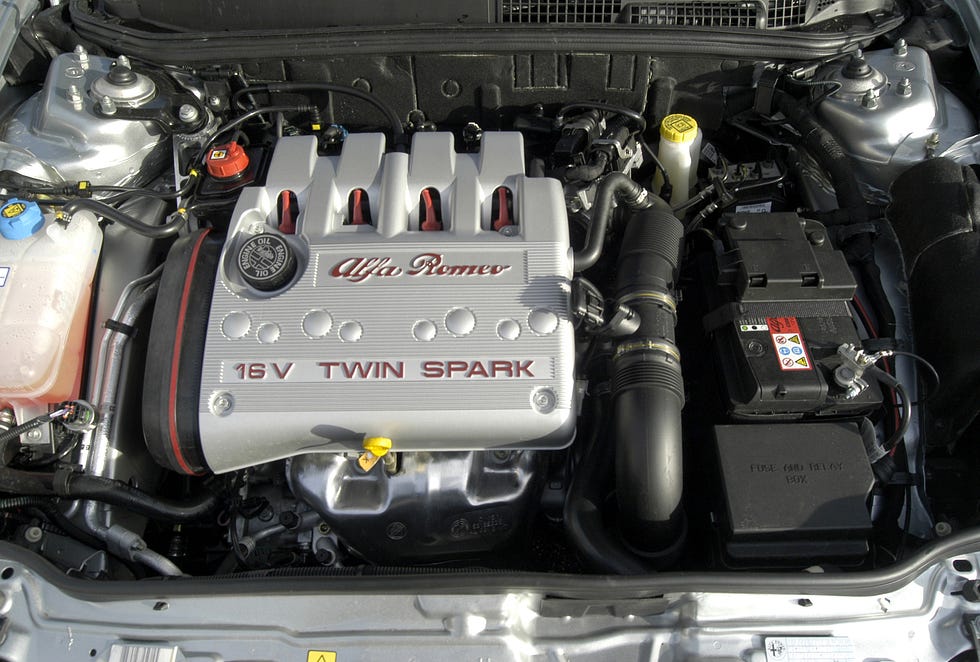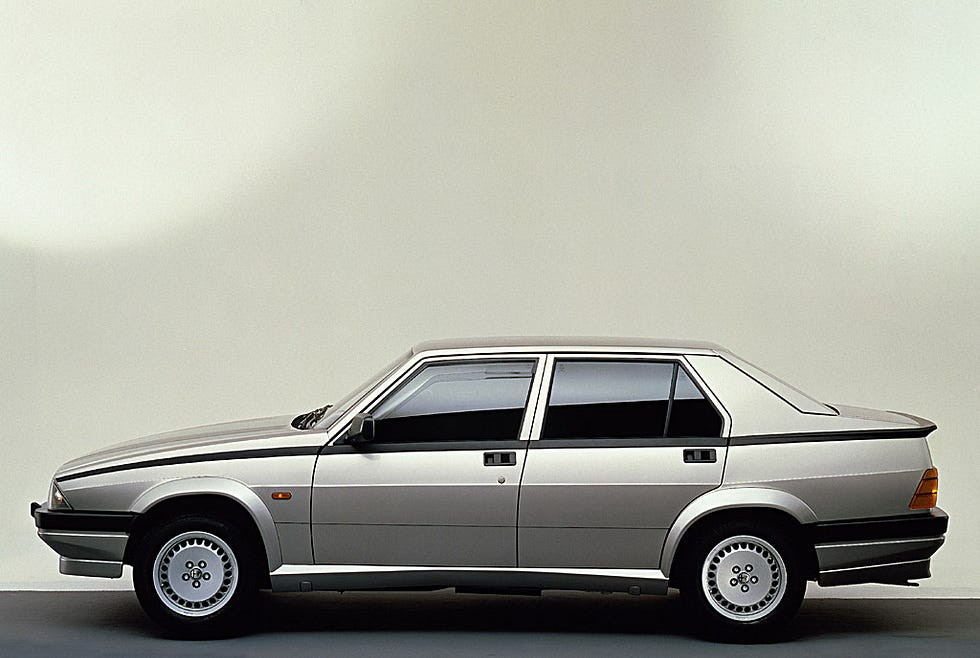Alfa Romeo’s Twin Spark engines
The words “Twin Spark” became almost synonymous with Alfa Romeo in the late Eighties and Nineties. Still, few know what it was all about, and even fewer know the reasons behind Alfa’s long-standing adoption of double ignition on its engines…
アルファロメオのツインスパーク・エンジン
80年代後半から90年代にかけて、「ツインスパーク」という言葉は、アルファロメオの代名詞のようになった。しかし、その意味を知る人は少なく、また、アルファが長年にわたってエンジンにダブルイグニッションを採用してきた理由を知る人はさらに少ない......。

GTのボンネットに搭載された後期ツインスパーク16V (c. Wheelsage.org)
It’s February of 1987.
Alfa Romeo presents a new version of its 75 family saloon, the 2.0 liters “Twin Spark.” Alfa itself had officially ceased to exist as a company entity just a few weeks earlier: its asset merged with Lancia’s ones into a newly formed company under Fiat’s control, called Alfa Lancia Industriale.
While that corporate entity only lasted until ’92, the words “Twin Spark” would go on much longer, becoming almost synonymous with the Milanese brand.
1987年2月のことである。
アルファロメオは、75ファミリー・サルーンの新バージョン、2.0リッターの "ツインスパーク "を発表した。その数週間前、アルファはランチアと合併してフィアット傘下のアルファ・ランチア・インダストリアルとなり、会社としての体をなさなくなったばかりだった。
この会社は92年までしか存続しなかったが、「ツインスパーク」という言葉はもっと長く続き、ミラノのブランドのほとんど代名詞となった。
Powering the future
By the late 1970s, the inline-four cylinder twin-cam engine known as “bialbero” that powered the bulk of Arese’s production was an over twenty-years-old design.
未来への原動力
1970年代後半、アレーゼの主力製品であった直列4気筒ツインカムエンジンは、設計から20年以上が経過し、「ビアベロ」と呼ばれるようになった。

80年代後半のビアベロエンジン(c. Wheelsage.org)
The future called for cleaner, more efficient engines. On top of that, the classic “bialbero” production costs were high due to the outdated tooling and processes used to make it. So Alfa’s engineers set out to design a brand new engine to replace it: a new block, new crank, and, of course, a brand new cylinder head, whose design built upon the experience gained on the race tracks with the GTAm.
Due to Alfa Romeo’s increasingly precarious financial position, that new engine was never made. Instead, the engineers would have to make do with designing a new cylinder head for the existing engine block.
The Twin Spark head’s two valves per cylinder were inclined at a much tighter angle (46° rather than the 80° of the old engine) for better thermal efficiency and a straighter inlet port.
The adoption of two spark plugs on opposite sides of the combustion chamber, instead of the usual central one, allowed to increase the diameter of the intake valve. Furthermore, the combustion was better controlled, leading to a smoother engine running at partial throttle openings. The package was then completed by Alfa’s patented variable valve timing on the intake camshaft and Bosch’s latest Motronic fuel injection. To say it was a success probably is an understatement.
未来には、よりクリーンで効率的なエンジンが求められていた。その上、旧式の「ビアベロ」は、製造に使用する金型や工程が旧式であったため、生産コストが高くなっていました。ブロック、クランク、シリンダーヘッドはもちろんのこと、GTAmで培った経験をもとに設計された新型のエンジンだ。
しかし、アルファロメオの経営状態が悪化したため、この新型エンジンは製造されることがなかった。その代わりに、既存のエンジンブロックに新しいシリンダーヘッドを設計することになった。
ツインスパーク・ヘッドでは、シリンダーごとに2つのバルブが、旧型エンジンの80°から46°へと傾斜し、熱効率が向上するとともに、インレットポートがストレートになった。
また、従来は燃焼室の中央にあった2本のスパークプラグが、燃焼室の反対側に配置されたことで、吸気バルブの直径を大きくすることが可能になった。さらに、燃焼のコントロールが向上し、パーシャルスロットル開度でのスムーズなエンジン走行が可能になった。さらに、インテークカムシャフトにはアルファが特許を持つ可変バルブタイミング、燃料噴射にはボッシュの最新型モトロニックが採用され、パッケージは完成した。おそらく成功したと言っても過言ではないだろう。
Back on the map
The introduction of the two liters Twin Spark engine on the 75 drastically changed the fortunes of this model. The Twin Spark’s performance not only re-established Alfa Romeo at the top of the European “two liters” class but, together with some neat styling tweaks inside and out, transformed the 75 into a much more desirable car than before.
地図に戻る
75に搭載された2リッターのツインスパーク・エンジンは、このモデルの運命を劇的に変えた。ツインスパークの性能は、アルファロメオをヨーロッパの2リッタークラスのトップに返り咲かせただけでなく、内外装のスタイリングにも手が加えられ、75は以前よりもはるかに魅力的なクルマに生まれ変わったのだ。

1987年式アルファ75ツインスパーク(c. Stellantis Emea Press)
From September of ’87, the same two liters engine, modified for transverse installation, would then power the front wheels of the stunning 164 flagship saloon, designed by Pininfarina’s Enrico Fumia.
87年9月からは、同じ2リッターエンジンを横置きに変更し、ピニンファリーナのエンリコ・フミヤがデザインしたフラッグシップサルーン164の前輪を駆動するようになった。
Phase two
1992 saw the debut of the 155, the front-wheel-drive replacement for the 75, and the new generation of Twin Spark engines designed to power it. These engines’ external layout was significantly modified to fit the model’s smaller engine bay, which called for a new plenum chamber and intake runners. In addition, the switch to static ignition got rid of the bulky distributors, and the hydraulic variator was now electronically controlled.
第2段階
1992年、75に代わる前輪駆動の155と、そのエンジンのために設計された新世代のツインスパークエンジンが発表された。エンジンルームの小型化に伴い、エンジンの外形レイアウトを大幅に変更し、プレナムチャンバーや吸気ランナーを一新した。また、スタティックイグニッションに変更され、大型のディストリビューターが廃止され、油圧バリエーターが電子制御化された。

1993年式アルファロメオ155 1.7 ツインスパーク(c.Stellantis Emea Press)
The two liters engine gained about 30 cubic centimeters of displacement, from the “classic” capacity of 1962cc to 1995cc. Below sat a 1.8 liters Twin Spark introduced for the first time, while an entry-level 1.7 liters Twin Spark variant was introduced in 1993, the latter without variable valve timing. These engines were manufactured at Alfa Romeo’s historic Arese plant, still using the old aluminum engine block design from the 1950s. But by 1995, the writing was on the wall for these 8-valve TS engines, as an all-new two liters Twin Spark 16v debuted under the bonnet of the sexy GTV and Spider.
2リッターエンジンは、1962ccの「クラシック」から1995ccへと約30立方センチメートルの排気量アップを果たした。その下には初めて導入された1.8リッター・ツインスパークと、1993年に導入されたエントリーレベルの1.7リッター・ツインスパーク(後者は可変バルブタイミングを備えていない)が搭載されていた。これらのエンジンは、アルファロメオの歴史あるアレーゼ工場で製造され、1950年代の古いアルミニウム製エンジンブロックの設計がそのまま使用されていた。しかし、1995年には、この8バルブTSエンジンは終焉を迎え、新型の2リッターツインスパーク16VがセクシーなGTVとスパイダーのボンネットの下にデビューした。
A new generation
By the late 1980s, Fiat Auto found itself producing a remarkably varied selection of engines in the 1.5 to 2.0 liters range. Fiat-Lancia’s legacy designs, like the “Lampredi” twin-cam four-cylinder, Alfa’s own classic twin-cam and its Twin Spark derivatives, plus the “boxer” engines from the Naples factory.
Such a wide variety of entirely different powertrains, made in separate factories and relatively small volumes, made little sense from an industrial point of view.
The new family of engines designed to replace them was characterized by a modular design that allowed a wide variety of inline-four or inline-five cylinders, petrol or diesel engines, to be made with the same tooling on a highly automated production line.
The engine block, a thin-wall iron casting, could house two counter-rotating balancing shafts, depending on the application. Most petrol engines’ aluminum heads had four valves per cylinder and an electronically controlled variator on the intake camshaft.
The adoption of four valves per cylinder pretty much ruled out double ignition.
新しい世代
1980年代後半になると、フィアット・オートは1.5リッターから2.0リッターまで、驚くほど多様なエンジンを生産するようになった。フィアット・ランチャのレガシーデザインであるランプレディ型ツインカム4気筒、アルファのクラシックツインカムとツインスパーク、そしてナポリ工場のボクサーエンジンなどだ。
このように多種多様なパワートレインを別々の工場で、比較的少量ずつ生産することは、産業的な観点からはあまり意味のないことであった。
それに代わって設計された新しいエンジン・ファミリーは、直列4気筒や直列5気筒、ガソリンエンジンやディーゼルエンジンなど多種多様なエンジンを、高度に自動化された生産ラインで同じ金型を使って作ることができるモジュール設計が特徴であった。
エンジンブロックは薄肉鋳鉄で、用途に応じて2本の逆回転バランスシャフトを内蔵することができた。ガソリンエンジンのアルミヘッドの多くは、1気筒あたり4バルブで、吸気カムシャフトには電子制御のバリエーターが搭載されていた。
この4バルブ化により、ダブルイグニッションは廃止された。
Or did it?
The decision that the engines destined for Alfa Romeos had to have double ignition anyway was primarily taken for marketing reasons and imposed on the engineers: the management knew the public expected Alfa Romeo engines to be somehow unique. Moreover, the success of the Twin Spark engines had made the TS moniker almost synonymous with the brand, so to keep writing Twin Spark on the back of the cars became important.
そうだろうか?
アルファロメオのエンジンはダブルイグニッションでなければならないというのは、マーケティング上の理由からエンジニアに押し付けられたもので、経営陣はアルファロメオのエンジンがどこかユニークであることを大衆が期待していることを知っていた。また、ツインスパーク・エンジンの成功により、TSという名称はアルファロメオの代名詞となりつつあり、車の後ろにツインスパークと書き続けることが重要となっていた。

ツインスパーク16Vの特徴的なヘッドデザイン(c. Stellantis Emea Press)
However, putting two spark plugs into a four-valve cylinder head was challenging, given the very little space available. This led to the peculiar solution of two plugs of different sizes placed centrally, side by side. These plugs were of very high quality, developed explicitly by NGK to last a minimum of 100.000 km.
しかし、4バルブシリンダーヘッドに2本のスパークプラグを入れるのは、スペースが限られているため困難だった。そこで、サイズの異なる2本のプラグを中央に並べて配置するという、特異な解決策がとられた。このプラグは、日本ガイシが独自に開発した10万km以上の耐久性を持つ高品質なものである。
Doing it in style
As mentioned previously, the new generation of Twin Spark engines debuted with the larger two liters variant in 1995 and did it in style, under the swoopy bonnets of the GTV and Spider designed, once again, by Pininfarina’s Enrico Fumia. The same unit became available on the 155 and the newly-introduced 145 Quadrifoglio Verde later the same year. By 1996, the smaller 1.6 and 1.8 16v engines gradually replaced the older Twin Spark engines on the 155.
By 1997, with the demise of the boxer, the 145 and 146 also switched to the new Twin Spark engines. Finally, at the bottom of the range, a new 1.4 liters variant was introduced, a short-lived engine, though, lasting in production for only three years before being “sacrificed” on cost grounds given its unique cylinder head casting.
スタイリッシュに
前述したように、新世代のツインスパーク・エンジンは1995年に大型の2リッター・エンジンでデビューし、ピニンファリーナのエンリコ・フミヤがデザインしたGTVとスパイダーで、流麗なボンネットを身にまとい、その姿を現わした。同年末には、同じユニットが155と新たに導入された145クアドリフォリオ・ヴェルデにも搭載されるようになった。1996年には、155に搭載されていた旧式のツインスパーク・エンジンに代わり、より小型の1.6および1.8 16vエンジンが徐々に採用されるようになった。
1997年には、ボクサーの廃止に伴い、145と146も新しいツインスパーク・エンジンに切り替わった。しかし、このエンジンは短命で、わずか3年しか生産されず、そのユニークなシリンダーヘッド鋳造のためにコスト面で「犠牲」にされたのである。

2.0ツインスパーク(可変吸気ランナー)(c. Stellantis Emea Press)
With the launch of the 156, the 1.8 and 2.0 liters Twin Spark engines were uprated with an electronically controlled variable inlet manifold. Still, the big news of the time was the launch of the revolutionary common-rail diesel engines. These would take the lion’s share of 156 and 147 sales, thanks to their blend of high performance and low fuel consumption.
The Twin Spark engines would get to live on until 2010 as the entry-level options for the 147 and GT models, even though their time had already passed, as the advent of direct petrol injection made dual ignition not only redundant but physically impossible.
156の発売と同時に、1.8リッターと2.0リッターのツインスパークエンジンは、電子制御式可変インレットマニホールドを採用してアップグレードされた。しかし、当時のビッグニュースは、革新的なコモンレール式ディーゼルエンジンの発売であった。高性能と低燃費を両立させたこのエンジンは、156と147の販売台数の大半を占めることになる。
ツインスパーク・エンジンは、147とGTのエントリー・レベル・エンジンとして2010年まで生き続けた。
~DeepLで翻訳しました。~
引用サイト:https://medium.com/roadster-life/alfa-romeos-twin-spark-engines-c500eef9b71d
注:記事中2箇所ほどあるリンク先は英語オンリーのサイトです。PC、スマホアンドロイドをお使いの場合
ブラウザをChromにして見ていただくと、Google翻訳で簡単に日本語が読めると思います。

マウス右クリックやアンドロイドでは画面長押しでも翻訳のコマンドが出てくると思います。
(環境によって変わると思いますが・・)
英語のレイアウトそのままで簡単に日本語に変わります!(DeepLのほうが自然な翻訳だとは思いますが・・)

iphoneの場合は以下を参照ください。
--------------------------------------------------------------------------------------------------------------------
この記事に関連する動画は2つあるようです。字幕も含めて日本語は一切なくて恐縮ですが、映像だけでも参考にしてください。
The Story Of The Alfa Romeo Twin Spark Engine - Part One
The Story Of The Alfa Romeo Twin Spark Engine - Part Two














